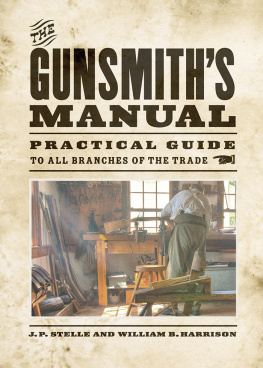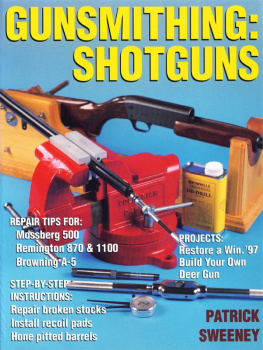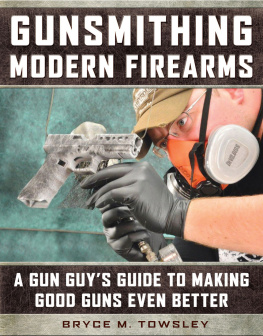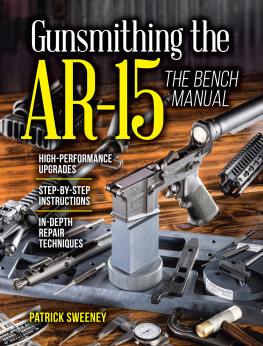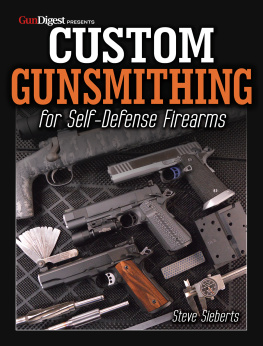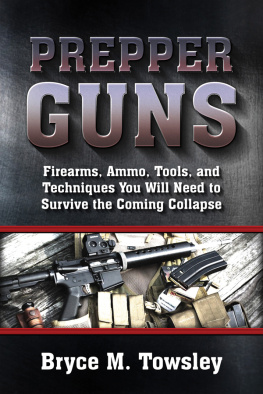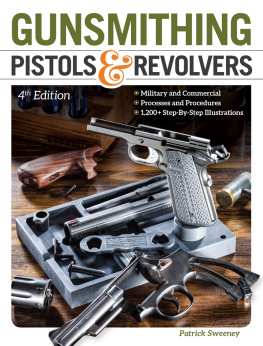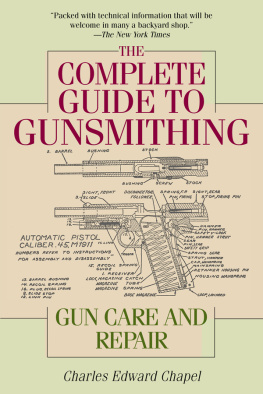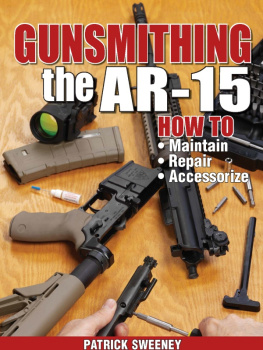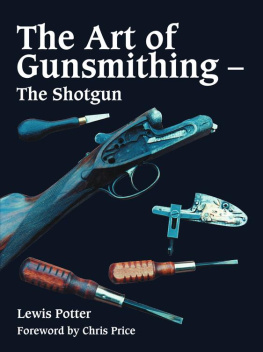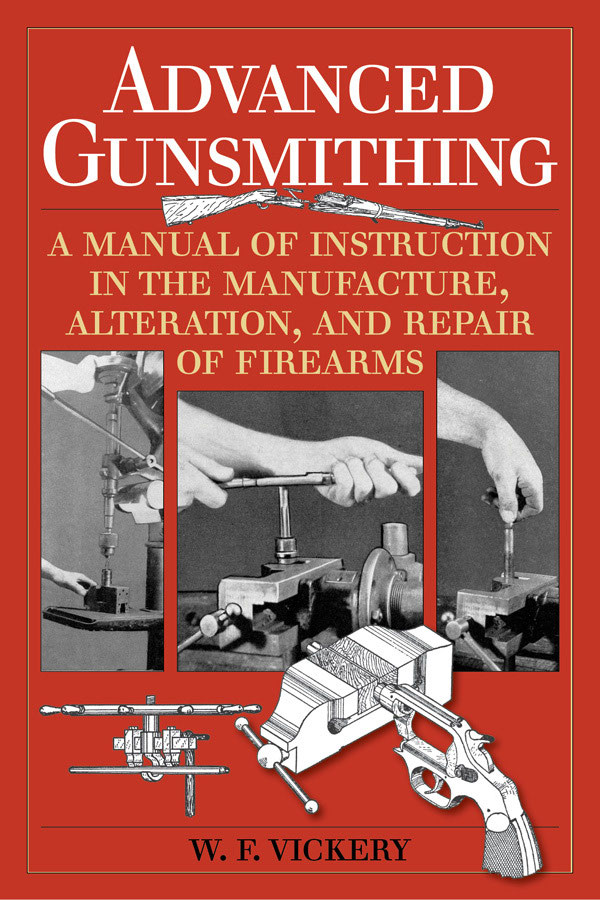Trigger-Pull Adjustment
Stoning-off the sear-notch face of a Krag cocking-piece, to obtain a cleaner pull. The proper placing of the notch face between the vise jaws, in order to retain a square bearing, is of greatest importance, as is also the frequent use of the magnifying glass to examine progress of the work. Use only fine-grained slip-stones for this operationthe shapes illustrated will all come in useful at times.
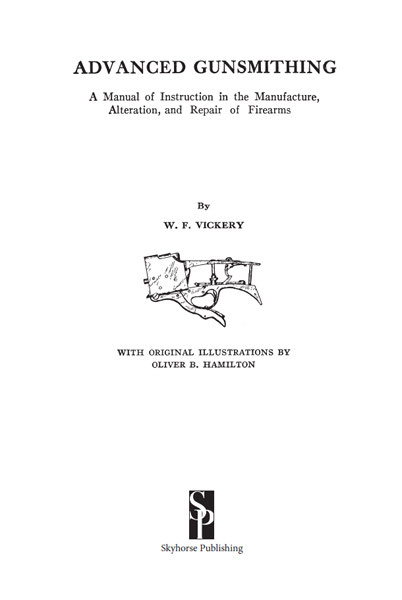
Copyright 1940 by Thomas G. Samworth
Special Contents Copyright 2012 by Palladium Press
First Skyhorse Publishing edition 2015
All rights to any and all materials in copyright owned by the publisher are strictly reserved by the publisher. No part of this book may be reproduced in any manner without the express written consent of the publisher, except in the case of brief excerpts in critical reviews or articles. All inquiries should be addressed to Skyhorse Publishing, West 36th Street, 11th Floor, New York, NY 10018.
Skyhorse Publishing books may be purchased in bulk at special discounts for sales promotion, corporate gifts, fund-raising, or educational purposes. Special editions can also be created to specifications. For details, contact the Special Sales Department, Skyhorse Publishing, West 36th Street, 11th Floor, New York, NY 10018 or info@skyhorsepublishing.com.
and Skyhorse are registered trademarks of Skyhorse Publishing, a Delaware corporation.
Visit our website at
Library of Congress Cataloging-in-Publication Data is available on file.
Cover design by Richard Rossiter
Print ISBN: 978-1-62914-438-2
Ebook ISBN: 978-1-62914-851-9
Printed in the United States of America
To
THE OF
THAT
JOHN M. BROWNING
Contents
Editors Note
Foreword
Advanced Gunsmithing
Chapter 1: Shop Equipment
Chapter 2: Barrel Changing and its Adjustments
Chapter 3: Chambering, Boring and Reaming Tools
Chapter 4: Rifling Tools and the Rifling of Barrels
Chapter 5: Reboring and Rechambering Old Rifles
Chapter 6: Action Work and Alterations
Chapter 7: Sights, Scopes and Small Parts
Chapter 8: Shotgun Repairs
Chapter 9: Problems of the and Other Rim-Fire Rifles
Chapter 10: Revolver and Automatic Pistol Jobs
Chapter 11: Cleaning, Clearing and Lapping Barrels
Chapter 12: Working With Hand Tools
Chapter 13: Notes On Firing-Pins
Chapter 14: Soldering and Brazing
Chapter 15: Forging and Welding
Chapter 16: Heat Treatment of Steel
Chapter 17: The Blueing of Firearms
Chapter 18: Cartridge Case and Bullet Dies
Chapter 19: Loading Tool Accessories and Appliances
Chapter 20: Postmortem
EDITORS NOTE
W. F. VICKERYS
ADVANCED GUNSMITHING
by Dr. Jim Casada
Wayne F. Vickery was one of the many experts who became a part of Thomas Samworths stable of writers for his Small-Arms Technical Publishing Company. Mr. Sam had an uncanny knack for locating what he described as gun cranks and then getting them to bring their knowledge to the printed page. Some of his contributorsindividuals such as Townsend Whelen, E. C. Crossman, Elmer Keith, Charles Askins, Sr., and Julian Hatcherwere professional freelance writers. Others, including Henry Edwards Davis, Paul Estey, John B. George, and Vickery, were simply men who possessed exceptional wisdom and experience in the fields they covered. Frequently, and this was the case with Vickery, they wrote a single book.
Precisely how Samworth initially established contact with Vickery is not known, although it seems likely he would have corresponded with him (or at least become familiar with Vickerys work as a gunsmith) while Samworth was still with the National Rifle Association serving as editor of The American Geographically they were a continent apart. Vickery lived in Boise, Idaho, while Samworth, once he left the NRA, lived in Delaware, North Carolina, and finally South Carolina. My researches revealed little about Vickery, although Samworths promotional material for this book is helpful. W. F. Vickery, he wrote, is a professional gunsmith of long experience, and is also a gun-crank and experimenter of advance degreeone who fully understands the complex ideas and requirements of the modern rifleman.
Gunsmiths are ordinarily thought of in the context of repair or modification, but Vickery not only worked on guns, he made them. Custom rifles from talented craftsmen such as Kenny Jarrett are all the rage in todays gun world, but it is worth remembering that similar work was being done generations ago. Vickery was nationally known in this regard, and he probably manufactured scores, if not hundreds, of custom rifles. Unless he had someone to whom he subcontracted the woodworking, he handled not only the metal aspects of producing a finished custom gun but the entire process. He apparently put aftermarket barrels on rifles, did woodwork, tinkered with actions, and indeed was capable if not highly skilled in all phases of gunsmithing. However, the book being reprinted is restricted to coverage of the metalworking portion of the craft.
There can be no question that Vickery knew his stuff. For many years this book was reckoned to be the bible of gunsmithing, and even today it has not been fully supplanted by modern texts. That is because it gives precise, easily understood instructions; features plenty of drawings (by Oliver B. Hamilton) to clarify complex matters; and is written in a fashion that makes a potentially dry-as-dust subject quite readable.
Some indication of its enduring value is provided by the many printings and editions of the book. While under the Small-Arms imprint, the book went through at least six printings or issues. The differences in these printings are minimal and involve things like the color or material used in the binding, changes in paper stock, the listing of Samworth titles published subsequent to the true first edition, and altered narrative information on the inside flaps of the dust jacket. The textual material remained unchanged.
The publishing rights left Samworth apparently sometime in the 1950s, although that is confusing because a reprint from the Telegraph Press in my personal collection predates, by a year, the final Samworth offering as listed by Brian R. Smith in his Samworth Books: A Descriptive The copy in question, dated 1955, has Small-Arms Technical Publishing Company on the title page but lists the Telegraph Press (a forerunner of Stackpole Books) on the reverse of that page. This is perhaps a mystery best left to bibliophiles, although it does suggest one crying needfor a detailed, annotated bibliography of Stack-pole sporting and firearms titles.
Advanced Gunsmithing was but one of numerous works Samworth published in this field, and the fact that he produced books that might have seemed, at least on the surface, to be competitive volumes attests to the widespread interest in the subject. Other related Samworth titles include Clyde Bakers Modern Gunsmithing (1928), R. H. Angiers Firearm Blueing and Browning (1936), Perry Frazers Elementary Gunsmithing (1938), Walter Howes Professional Gunsmithing (1946), A. D. Newells Gunstock Finishing and Care (1949), Roy Dunlaps Gunsmithing (1950), Monty Kennedys The Checkering and Carving of Gunstocks (1952), and three books by Alvin Linden on various aspects of gunstocks. There was also a reprint of J. P. Stelle and William B. Harrisons The Gunsmiths which was originally published in 1883. Admittedly, some of these books focus on specialized branches of the gunsmithing trade, but there are six titles that could be construed as competitive with Vickerys work.


